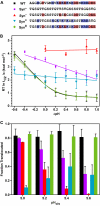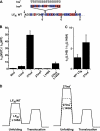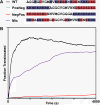Charge requirements for proton gradient-driven translocation of anthrax toxin
- PMID: 21507946
- PMCID: PMC3123086
- DOI: 10.1074/jbc.M111.231167
Charge requirements for proton gradient-driven translocation of anthrax toxin
Abstract
Anthrax lethal toxin is used as a model system to study protein translocation. The toxin is composed of a translocase channel, called protective antigen (PA), and an enzyme, called lethal factor (LF). A proton gradient (ΔpH) can drive LF unfolding and translocation through PA channels; however, the mechanism of ΔpH-mediated force generation, substrate unfolding, and establishment of directionality are poorly understood. One recent hypothesis suggests that the ΔpH may act through changes in the protonation state of residues in the substrate. Here we report the charge requirements of LF's amino-terminal binding domain (LF(N)) using planar lipid bilayer electrophysiology. We found that acidic residues are required in LF(N) to utilize a proton gradient for translocation. Constructs lacking negative charges in the unstructured presequence of LF(N) translocate independently of the ΔpH driving force. Acidic residues markedly increase the rate of ΔpH-driven translocation, and the presequence is optimized in its natural acidic residue content for efficient ΔpH-driven unfolding and translocation. We discuss a ΔpH-driven charge state Brownian ratchet mechanism for translocation, where glutamic and aspartic acid residues in the substrate are the "molecular teeth" of the ratchet. Our Brownian ratchet model includes a mechanism for unfolding and a novel role for positive charges, which we propose chaperone negative charges through the PA channel during ΔpH translocation.
Figures








Similar articles
-
Electrostatic ratchet in the protective antigen channel promotes anthrax toxin translocation.J Biol Chem. 2012 Dec 21;287(52):43753-64. doi: 10.1074/jbc.M112.419598. Epub 2012 Oct 31. J Biol Chem. 2012. PMID: 23115233 Free PMC article.
-
Protein translocation through the anthrax toxin transmembrane pore is driven by a proton gradient.J Mol Biol. 2006 Feb 3;355(5):968-79. doi: 10.1016/j.jmb.2005.11.030. Epub 2005 Dec 1. J Mol Biol. 2006. PMID: 16343527
-
Role of the α Clamp in the Protein Translocation Mechanism of Anthrax Toxin.J Mol Biol. 2015 Oct 9;427(20):3340-3349. doi: 10.1016/j.jmb.2015.08.024. Epub 2015 Sep 5. J Mol Biol. 2015. PMID: 26344833 Free PMC article.
-
Membrane translocation by anthrax toxin.Mol Aspects Med. 2009 Dec;30(6):413-22. doi: 10.1016/j.mam.2009.06.003. Epub 2009 Jun 27. Mol Aspects Med. 2009. PMID: 19563824 Free PMC article. Review.
-
Anthrax Toxin: Model System for Studying Protein Translocation.J Mol Biol. 2024 Apr 15;436(8):168521. doi: 10.1016/j.jmb.2024.168521. Epub 2024 Mar 7. J Mol Biol. 2024. PMID: 38458604 Review.
Cited by
-
The N-terminus of the Clostridioides difficile transferase A component directs toxin activity and potency.mBio. 2025 Jan 8;16(1):e0240524. doi: 10.1128/mbio.02405-24. Epub 2024 Nov 29. mBio. 2025. PMID: 39611841 Free PMC article.
-
Obstructing toxin pathways by targeted pore blockage.Chem Rev. 2012 Dec 12;112(12):6388-430. doi: 10.1021/cr300141q. Epub 2012 Oct 11. Chem Rev. 2012. PMID: 23057504 Free PMC article. Review. No abstract available.
-
Bacillus anthracis edema factor substrate specificity: evidence for new modes of action.Toxins (Basel). 2012 Jul;4(7):505-35. doi: 10.3390/toxins4070505. Epub 2012 Jul 6. Toxins (Basel). 2012. PMID: 22852066 Free PMC article. Review.
-
Peptide- and proton-driven allosteric clamps catalyze anthrax toxin translocation across membranes.Proc Natl Acad Sci U S A. 2016 Aug 23;113(34):9611-6. doi: 10.1073/pnas.1600624113. Epub 2016 Aug 9. Proc Natl Acad Sci U S A. 2016. PMID: 27506790 Free PMC article.
-
Designed azolopyridinium salts block protective antigen pores in vitro and protect cells from anthrax toxin.PLoS One. 2013 Jun 20;8(6):e66099. doi: 10.1371/journal.pone.0066099. Print 2013. PLoS One. 2013. PMID: 23840407 Free PMC article.
References
Publication types
MeSH terms
Substances
Grants and funding
LinkOut - more resources
Full Text Sources

